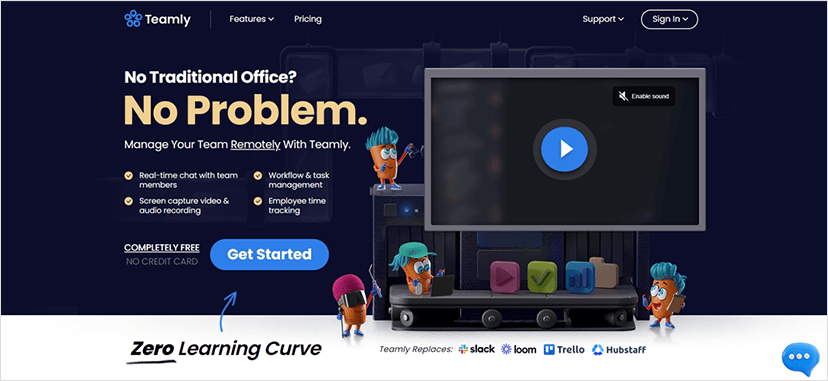
Click the button to start reading
Project Objectives: Examples and Tips to Help You Hit the Bullseye
Here you are standing in a buzzing boardroom where discussions fill the air.
With each conversation, you’re trying to define and solve a business problem.
But walking into this boardroom without clear goals is like trying to find your way blindfolded.
When it comes to your next project, understanding the power of objectives is key. Just as architects rely on blueprints to ensure a strong building, project managers use objectives as a roadmap to success.
Join us as we explore specific examples of project objectives across industries. You’ll discover what separates good objectives from not-so-good ones. What’s more, you’ll get tips to help you write project objectives that easily help you accomplish your goals.

What Is a Project Objective?
Project objectives are the results you aim to achieve when your project is done. In project management, they give you and your team a clear purpose.
Like a shared vision, project objectives bring the team together, ensuring everyone pulls in the same direction.
What Questions Do Project Objectives Answer?
Objectives help you define the purpose of your project by answering several important questions. Here are a few examples:
- What’s our project aiming to achieve?
- What results do we expect?
- Why do we start this project? What specific problem is it addressing?
- How will we measure and evaluate success?
- What are the milestones for the project?
- What’s the purpose and direction of the project?
- What’s the timeframe for completing the project?
- Who are the main stakeholders, and what are their expectations?
- What resources (financial, human, etc.) are required for the project?
Project Objective Examples Across Industries
Alright, let’s find out how diverse project objective examples can be. As you’ll see, they span various industries and goals. But what unites them is the specific target that helps to plan and complete each project.
Business Improvement
- Increase quarterly sales by 5%.
- Improve inventory management to reduce the duration of restocking by 20%.
- Increase customer satisfaction scores by 25%.
Technology Upgrade
- Migrate all company servers to cloud infrastructure by the end of the quarter.
- Improve data security protocols to achieve ISO 27001 certification.
- Minimize downtime by increasing system uptime to 99.9%.
Retail Industry
- Launch a loyalty program that increases customer retention by 15%.
SaaS Industry
- Develop a new feature that increases daily active users by 15%.
- Enhance security protocols to achieve SOC 2 compliance within six months.
- Build a self-service knowledge base to reduce customer support response time. The expected outcome is a 20% decrease in support tickets.
Marketing Industry
- Launch an Instagram campaign to increase brand awareness. Within two months, the number of followers should grow by 20%.
- Offer personalized content to improve email marketing click-through rates by 15%. Use targeted segmentation to achieve the goal.
- Increase website traffic by 30% within a year through content marketing and SEO optimization.
Healthcare Enhancement
- Develop a mobile app for patients to schedule appointments. Ensure the app can handle 100,000 users concurrently without crashing.
Environmental Initiative
- Plant 20,000 trees in urban areas by the end of the year.
- Implement a plastic waste recycling program to reduce landfill waste by 50%.
Educational Project
- Create an online learning platform for engineering students with video lessons and interactive quizzes. Ensure the platform loads within 2 seconds for a quick user experience.
Now, use these project objectives examples to get specific about your next project’s target. Don’t forget to make your objective measurable and achievable.

Putting It into Context: A Sample of Handling Project Objectives
Project: Launching a new online store
Objective: Increase online sales by 10% in the next six months.
Scenario: A retail company is working on building a new online store. The big goal is to sell more things online and, eventually, get better known in the digital world.
Steps Taken:
- Understanding the ultimate target. At this stage, important talks happen with key people. The marketing team, tech experts, and top bosses are all involved. They share ideas and agree on what the project should achieve.
- Setting an objective. The project gets a clear objective that everyone understands. They want to sell 10% more things online in the next six months.
- Making a plan. Afterwards, they come up with a big plan that says what needs to be done, step by step.
- Getting what’s needed. The tech experts join in to make sure they have everything they need to build the online store. From tools and technology to people with the right skills, they find the necessary resources.
- Being ready for problems. It’s time to think about what might go wrong. For example, the online store may crash, or things may not be ready on time. They make plans to manage these risks if they occur.
- Keeping an eye on things. As time goes on, they keep checking if they’re still on track to reach their goal. If something needs to change, they do it so they can still reach the target.
- Seeing how it went: After six months, they look at how well they did. They look at how many people visited the store and what customers said. If they sold 10% more as they planned, they would mark this project objective example as a success.

Distinguishing Between Effective and Ineffective Project Objectives
You might already know this, but let us give you a kind reminder.
Good project objectives should be specific, measurable, achievable, relevant, and time-bound (SMART). They should clearly outline what you want to achieve, by when, and how you’ll know you’ve been a success.
In contrast, bad project objectives lack these qualities, making it difficult to track progress or assess results.
Let’s have a look at each of these categories:
Poor Project Objectives Examples (+ Reasons They Aren’t Effective)
- Improve website performance. (This objective is vague and doesn’t specify the aspect of performance and doesn’t set any measurable target.)
- Launch a new software product. (It lacks clarity on the target market and the product’s purpose)
- Build a better customer support system. (Again, this one is unclear. So, what aspects need improvement? How will success be measured?)
- Increase social media presence. (This objective isn’t effective because it doesn’t provide details about the platform, metrics, or timeframe.)
- Train employees on new procedures. (It’s too general and doesn’t specify the evaluation criteria or desired results.)
Effective Project Objectives Examples
- Increase user engagement on the company’s mobile app by 25% within three months. Use personalized recommendations as the main technique for achieving the objective.
- Launch a new skincare product line that generates $500,000 in sales revenue. Timeframe: within the first year of market entry.
- Reduce production waste by 15% by the end of the fiscal year. Use process optimization and employee training to achieve the objective.
- Implement a customer feedback system that improves 5-star ratings from customers by 20%. Timeframe: over six months.
- Complete the construction of a new office building within the allocated budget and set a timeline. Make sure the project meets all safety and quality standards.

Project Objectives vs. Project Plans
As we’ve already seen, project objectives are the specific goals of a project. They show what the project wants to achieve – like getting better results or finishing a job. They help everyone know where to go and decide how to use their time and tools.
But then, there’s the project plan. This is like a detailed map that tells how to reach the objectives. It shows what tasks to do, who does what, and when the deadlines are. While objectives say what we want, the project plan says how we’re going to do it.
Both objectives and the project plan work in a combo. Together, they help show us where we want to be and the steps to get there.
Project Objectives vs. Project Outcomes
Let’s take an example. A project might set the objective to boost website traffic by 20% over the course of the next quarter. That’s a clear and measurable objective for your project.
On the flip side, we have project outcomes. These are the actual results or impacts that become visible once the project is finished. They showcase the real changes, whether they’re something you can count or not.
To explain, a project’s outcomes might include a tangible 25% increase in website traffic. Also, this can be accompanied by an intangible improvement in user engagement.
Project Objectives vs. Project Goals
If objectives are the targets a project aims to hit, project goals are like the big dreams the project wants to make real. In other words, project goals are the main reason the project exists.
For instance, a project’s goal might be to become well-known online and sell to more people. This dream guides the project to create a modern online store that works great on phones and computers.

Crafting Exceptional Project Objectives: Expert Tips to Guide You
Writing effective project objectives is essential for successful project management. Here are some tips to help you craft your project objective examples:
1. Use Action Verbs
Start objectives with strong action verbs like “increase,” “reduce,” “develop,” or “implement.” Why? Because action verbs add clarity to your project objectives. They convey a sense of direction and focus.
2. Focus on Results
Don’t start with tasks. Rather, state the desired outcomes or benefits, emphasizing what you’ll achieve. Only then focus on clarifying the necessary tasks.
This approach gives you a clearer picture of the project’s value and helps you understand the end goals.
3. Consider Stakeholders
Next, keep in mind the interests of every party concerned. Address the needs and expectations of all stakeholders when formulating objectives. By addressing their concerns and requirements, you ensure their participation and support.
4. Prioritize
Limit the number of objectives to the most critical ones. This helps maintain focus and prevent scope creep. Identify the “must-have” objectives and don’t negotiate on them.
5. Align with Strategy
According to PMI’s research, 57% of high-performers match their projects with the organization’s bigger strategy. And that’s quite natural.
Without a long-term vision, you may complete the project and be left with the question, “What’s next”? Linking your project objectives with the company’s broader goals, on the other hand, will help you stay on track. You’ll know where you’re heading and whether your project is relevant.
6. Test for SMARTness
Apply the SMART criteria to ensure your objectives meet the five essential qualities. As mentioned earlier, these are: Specific, Measurable, Achievable, Relevant, and Time-Bound.
Compared to vague goals, specific objectives lead to higher performance and motivation. Oh and you might want to consider examples of SMART goals to help you with testing your project objectives.
7. Seek Feedback
As the saying goes, two heads are better than one. So, share your objectives with team members and stakeholders to get different viewpoints.
Involving them in the objective-setting process improves collaboration. Plus, it gives a sense of ownership.
8. Reverse Engineer Success
Start with the end in mind. How? Imagine your project is already a success. Then, work backward to define objectives that lead to that outcome. This approach helps ensure that objectives are aligned with the final project outcome.
9. Quantify Intangibles
While measurable objectives are important, don’t shy away from evaluating intangible outcomes. Use indicators to measure concepts like improved brand perception or improved user experience.
10. Challenge Assumptions
Instead of just doing things the usual way, be a bit of a detective. Ask questions about what people always assume is true. This helps you come up with objectives that break the rules in a good way!
11. Explore Second-Order Effects
Imagine dropping a pebble in the water. The ripples it makes can affect things far away, right? When you set a goal, think about how it might change other areas of the project, team, or organization.
For instance, imagine you’re working on a school project to plant a community garden. Your main goal is to create a beautiful green space for everyone to enjoy. But what about the second-order effects? Well, as the garden flourishes, it might bring people closer together. Kids might learn about plants, and maybe even new friendships sprout up.
See how that works? Your project isn’t just about the plants – it’s about all the other things that happen because of it.
12. Focus on Scalability
As you set your project objectives, think about how each goal contributes to the scalability of your business. Here’s a case in point. Imagine you’re running a software company that creates a language-learning app. Right now, your app is gaining popularity among students in your country. But what if you could take your success to an international level?
Scalability means designing your app’s infrastructure in a way that it can handle not only the current user base. It can be used by a much larger global audience.
By focusing on scalability, you’re ensuring that your app won’t crash or slow down due to the increased load.
13. Balance Short-Term and Long-Term
You might plan for a vacation. At the same time, you might also think about your next career step and consider taking a degree. The same is true for your business. So aim to set both short-term and long-term goals. Strive for a blend of short-term wins and long-term strategic objectives. This maintains momentum while driving sustained progress toward larger goals.
14. Conduct a Stress Test
Pretend your objective is a super strong bridge. Try to break it by thinking of really tough things that could happen. Heavy traffic, earthquakes, and storms… Will it survive? If yes, you’ve built a strong objective.
By conducting a stress test, you’re essentially giving your project a chance to prove its mettle. This safeguards your project even in the most demanding business landscapes.

What Tools to Use When Dealing with Project Objectives?
Of course, the choice of tools depends on the complexity and nature of your project. Your team’s preferences may have an impact, too. But there are several tools and techniques you can use when dealing with any project objective examples. Here are a few:
Gantt charts. Use Gantt charts to visualize project tasks, timelines, and dependencies. They help in planning and tracking progress toward objectives.
SWOT analysis. Conduct a SWOT analysis to identify project strengths, weaknesses, opportunities, and threats. This helps align objectives with the project’s context.
Project management software. Tools like Teamly or Jira will help you plan, execute, and track project tasks and objectives.
Risk management techniques. Identify potential risks that could affect objectives and develop strategies to mitigate them.
KPIs (Key Performance Indicators). Establish relevant KPIs to measure progress and success.
Feedback mechanisms. Set up feedback loops with stakeholders to continuously assess whether objectives are being met.
Documentation. Keep detailed documentation of project objectives, plans, and progress. This will help you ensure clarity and accountability.
Decision matrix. Use decision matrices to prioritize tasks and activities. By the way, they should directly contribute to achieving project objectives.

How to Use Teamly When Dealing with Project Objectives?
Wanna handle project objectives effectively? Teamly is your trusty helper. It makes sure your projects go smoothly, and you achieve what you planned.
As a first step, create a project in Teamly, giving it a name and specifying exactly what you want to do. Then, break down your project into smaller chunks. Assign tasks to team members and set deadlines. You can even mark how important each task is.
What’s more, Teamly helps you see how things are going. Is a task being worked on? Is it done? Or maybe something takes longer to be completed? You watch important signs to know if your project is on track. The best part? Everything is served up in a visual, easy-to-understand way.
Teamly’s got your communication game covered too, with real-time chats and nifty screen recordings. Because smashing objectives is a team sport, and Teamly is your valuable player.
Let’s Sum It Up!
You have the courage to deliver your project. And your dedication knows no bounds. Yet, even with the strongest determination, you’ll go astray without effective objectives.
Use the project objective examples in this article to create effective targets that work. Bring in the tools that’ll simplify the entire process – from brainstorming to delivery.
You’re ready now. As you walk your path, let your project objectives guide you every step of the way.
















